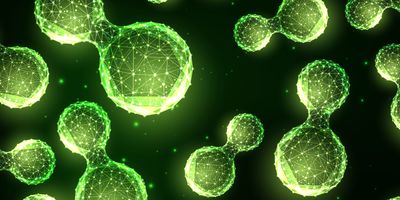Unlocking the Secrets of the Simplest Molecule
Researchers use precise lasers and spectroscopy to shed light on the fundamental physics and cosmological origins of H2+
Key Takeaways:
- As one of the earliest molecules post-Big Bang, H2+ is crucial for astrophysics and fundamental physics due to its elemental composition and role in cosmic evolution
- In exciting new research, physicists have successfully measured H2+ vibrations directly using a complex laser system, confirming theoretical predictions with unprecedented accuracy
- This precise spectroscopic analysis not only validates theoretical models but also aids in determining fundamental physical constants, paving the way for future studies on matter-antimatter comparisons and exploring new physics frontiers
The simplest possible molecule, H2+, was one of the very first molecules to form in the cosmos. This makes it significant for astrophysics, but also an important object of research for fundamental physics. It is difficult to study in experiments. However, a team of physicists from Heinrich Heine University Düsseldorf (HHU) has now succeeded in measuring the vibrations of the molecule with a laser for the first time. The result matches the theoretical prediction very closely, as the researchers now describe in the scientific journal Nature Physics.
H2+ was one of the first molecules to form after the Big Bang. It consists of the most fundamental components that were formed very early on in the universe: two hydrogen nuclei (the protons) and one electron. The electron binds the two protons together to form the molecule. In the interplay of particle movements and forces, the two protons vibrate and rotate.
Despite its relative simplicity, H2+ has remained relatively unexplored to date. Due to the charge and mass symmetry of the two atomic nuclei, the molecule absorbs and emits almost no visible and infrared radiation. Accordingly, it is almost impossible to observe it with telescopes, meaning that it is extremely difficult for astronomers to find H2+ in the universe and study it.
The different vibrational and rotational states of the molecule correspond to specific excitation energies. When a molecule transitions between two such states, it absorbs or emits a characteristic amount of energy, a photon. This is a quantum of electromagnetic radiation with a specific frequency. Previous laboratory experiments have mostly measured these quanta of H2+ indirectly, and none of them have used lasers.
Postdoc Dr. Soroosh Alighanbari, doctoral student Magnus Schenkel, and Professor Stephan Schiller, PhD from the Institute for Experimental Physics at HHU, have now taken the first direct look at how the H2+ molecule can be made to rotate and vibrate using laser light. Magnus Schenkel developed a unique laser system that proved effective in exciting a transition between two vibrational states. The laser system is particularly complex because it requires monochromatic laser radiation, i.e., having a very specific frequency in the infrared spectrum at a wavelength of 2.4 micrometers, and high power.
The aim of the physicists in Düsseldorf was to measure the frequency of the required radiation quanta as precisely as possible, and they achieved an unprecedented level of accuracy in their experiments. Their measurements, which they describe in detail in Nature Physics, revealed a frequency value that matched the theoretical predictions. The key aspect here was that the physicists confined the molecules to be examined in a trap in which a further laser cooled them to a temperature close to absolute zero.
Comparing the precise measurement of the rotational and vibrational energies of H2+ with their theoretical calculation also has a more fundamental area of application: it enables testing of the fundamental laws of physics that govern the interaction between particles since these laws form the basis for the theoretical calculation of the energies.
In addition, the energies of H2+ depend on fundamental constants of physics, such as the proton-electron mass ratio. Careful measurement of the energies therefore allows the determination of the physical constants. Professor Schiller and his team have now succeeded in achieving this using laser spectroscopy. The mass ratio was determined with a relative uncertainty of 3×10-8. That is not as accurate as with alternative methods, but this measurement is just the first step.
In the future, the physicists are aiming to improve their measurement results further. Dr Alighanbari, one of the authors of the study: “We tested the potential of our approach with a ‘cousin’ of H2+—the molecule HD+—which allowed us to proceed much more quickly.” In HD+, a proton is replaced by a deuteron, which makes the molecule more accessible in spectroscopic terms. Alighanbari continues: “We can actually make even more precise measurements using our apparatus, motivating us to try again with H2+ in the near future.”
The possibility of performing ultra-precise spectroscopy of vibrational transitions in H2+ also opens up a more far-reaching perspective of exploring new frontiers in physics. Professor Schiller: “Our current result is the very first step towards a precise comparison of the behavior of matter and antimatter: We would use spectroscopy of H2+ and its antimatter counterpart to seek extremely small differences that may exist in their vibration energies. Such measurements may be significant for our understanding of why our universe is full of matter, yet barely contains any antimatter.”
Background: Why is spectroscopy of H2+ so difficult?
The difference between HD+ and H2+ is that HD+ has an electric dipole moment, which H2+ lacks. That is why the team made use of the molecule’s electric quadrupole moment. However, their transition rate is substantially lower compared with electric dipole moments. The physicists solved this issue by using a high-performance laser.
- This press release was originally published on the Heinrich-Heine University Düesseldorf website

